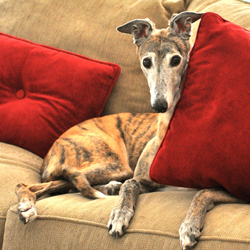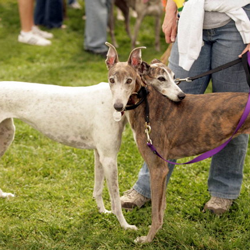HEALTH-GREYHOUNDS ARE DIFFERENT
Heat Stroke and Over-Exertion in Your Greyhound
Heatstroke and over-exertion can cause permanent damage to muscle fibers, kidneys, and other organs, and it can kill your Greyhound. Even within the GreySave family, we have seen young and healthy as well as older dogs experience heatstroke or over-exertion, and unfortunately some have died.
Although our dogs are athletes, they are retired athletes. After only a few months in a home, your Greyhound is no longer at the level of physical conditioning that he was on the track.
Heatstroke or over-exertion can damage your dog’s organs the same way a high fever does. It can happen while on a walk, playing at a dog park, running in your own back yard, or even while simply enjoying a warm day outside. Unfortunately, many pet owners don’t know the signs of a dog in trouble from heatstroke or over-exertion.
How to Recognize Heat Exhaustion
If you are walking your dog, or if he is running in your yard or at a dog park, watch for these danger signs. Remember, heat related deaths can happen in even moderately warm weather.
How to Treat Heatstroke
Once your dog exhibits one or more of the above symptoms, it is critical that you act immediately. Any delay can mean serious consequences--even death.
1) Cool the Greyhound immediately
2) Transport to vet
Even if the dog seems to recover, it is a good idea to visit a veterinarian immediately. He or she may prescribe administering IV fluids to flush the kidneys of harmful byproducts leaking from damaged muscles or caused by dehydration.
How to Prevent Heatstroke
In Closing
Organ damage and death from heat exhaustion and over exertion is preventable, but you are key to your dog’s well being.
Find out more about protecting your Greyhound at the following websites:
http://www.gcnm.org/heatstroke.html
http://www.greyhoundgang.com/medical-heatexhaustion.php
http://www.ehow.com/about_6130722_greyhounds-heat-stroke.html
See "Hot Weather Dangers" in our Care section.
“The frequency with which adopters report Greyhounds ‘dropped dead from a heart attack,’ when no previous indications of heart problems existed, suggests that death by heatstroke or [over-exertion] may not be so uncommon.”
From “Heat stroke in Greyhounds: What you want to know” by Judy Kody Paulsen, “Heatstroke in Greyhounds: What you need to know,” gcnm.org
Heatstroke and over-exertion can cause permanent damage to muscle fibers, kidneys, and other organs, and it can kill your Greyhound. Even within the GreySave family, we have seen young and healthy as well as older dogs experience heatstroke or over-exertion, and unfortunately some have died.
Although our dogs are athletes, they are retired athletes. After only a few months in a home, your Greyhound is no longer at the level of physical conditioning that he was on the track.
Heatstroke or over-exertion can damage your dog’s organs the same way a high fever does. It can happen while on a walk, playing at a dog park, running in your own back yard, or even while simply enjoying a warm day outside. Unfortunately, many pet owners don’t know the signs of a dog in trouble from heatstroke or over-exertion.
How to Recognize Heat Exhaustion
If you are walking your dog, or if he is running in your yard or at a dog park, watch for these danger signs. Remember, heat related deaths can happen in even moderately warm weather.
- Heavy panting, perhaps lots of thick, ropey saliva
- Red flushed ears and nose
- Weakness, possibly difficulty walking (In serious cases, fainting or seizures)
How to Treat Heatstroke
Once your dog exhibits one or more of the above symptoms, it is critical that you act immediately. Any delay can mean serious consequences--even death.
1) Cool the Greyhound immediately
- STOP all activity now--don’t wait! Move the dog into a cool place.
- Spray the dog with cold water. Begin with the feet and work up.
- Drape the dog with wet towels, especially around the belly and between the legs. Refresh the towels frequently so they stay cool; otherwise the covering can add heat to the dog.
- Avoid cooling too fast and producing a shivering response as this can create more heat in the body.
2) Transport to vet
Even if the dog seems to recover, it is a good idea to visit a veterinarian immediately. He or she may prescribe administering IV fluids to flush the kidneys of harmful byproducts leaking from damaged muscles or caused by dehydration.
How to Prevent Heatstroke
- The most important thing you can do to protect your Greyhound is to BE AWARE. Monitor your dog as you would a young child.
- Your Greyhound is accustomed to giving his all on the track. He concentrates on “the now” and may not know when to stop.
- If you are on a walk or your dog is exercising, take these precautions:
- Always have water available to drink as well as a squirt bottle of ice water
- Squirt your dog with water frequently (wet his coat, his ears, his legs and belly)
- Keep your dog’s activity at a moderate level. Remember, your dog may suffer from what we humans call “weekend warrior syndrome”--exercising too rigorously after a period of non-activity.
- Act immediately at the first sign of exhaustion in your dog.
In Closing
Organ damage and death from heat exhaustion and over exertion is preventable, but you are key to your dog’s well being.
Find out more about protecting your Greyhound at the following websites:
http://www.gcnm.org/heatstroke.html
http://www.greyhoundgang.com/medical-heatexhaustion.php
http://www.ehow.com/about_6130722_greyhounds-heat-stroke.html
See "Hot Weather Dangers" in our Care section.
“The frequency with which adopters report Greyhounds ‘dropped dead from a heart attack,’ when no previous indications of heart problems existed, suggests that death by heatstroke or [over-exertion] may not be so uncommon.”
From “Heat stroke in Greyhounds: What you want to know” by Judy Kody Paulsen, “Heatstroke in Greyhounds: What you need to know,” gcnm.org









